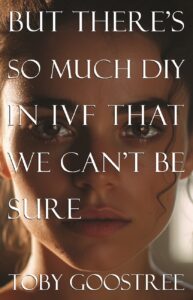Poet Toby Goostree joins me today to chat about his new book, But There’s So Much DIY in IVF That We Can’t Be Sure.

Bio:
Toby Goostree has his MFA in Poetry from The University of Arizona. His first book, But There’s So Much DIY in IVF That We Can’t Be Sure, was published by Fernwood Press in 2024. His work has appeared in The Cincinnati Review, Midwest Quarterly, Harbor Review and others. He lives in Kansas City.
What do you enjoy most about writing poems?
Athletes talk about getting in the zone and, for me, getting into flow, losing myself in a thought, is real happiness. Words help me pin things down while also always holding some part of experience out of reach and, in that way, like an athlete, I’m involved in the push-and-pull of a sport. It’s not competitive, but I’m not in control either—something like another team is playing against me and I love that.
Can you give us a little insight into a few of your poems – perhaps a couple of your favorites?
The primary tool in my first book is a simple one: juxtaposition and contrast. The poem that would most easily locate readers in the story and familiarize them with the concepts in the book would be Moses, the poem I used for the book trailer (https://www.youtube.com/watch?v=8kscUXPez5E). It uses the natural break in the sonnet as an opportunity for juxtaposition/contrast, with the octave laying out the story of Moses’ mother placing him in the river while the sestet, borrowing the river imagery, imagines the speaker’s wife looking for a child along the riverbank. While not dealing with IVF directly as many of the poems do, the connection and contrast between the stories makes each more compelling.
Another tool I used in the first book that I wouldn’t ordinarily use was to end a poem mid-line, or mid-thought, without any final grammar. I did this in two poems, once because a speaker’s voice breaks as he has an epiphany and once to contrast the orderliness of science—described in sentences with punctuation—with the unpredictability of prayer and God, embodied by a lack of punctuation.
I love narrative and I’m always looking for tools that help me tell a story more effectively.
What form are you inspired to write in the most? Why?
I went to the Sewanee Young Writer’s Conference when I was 16 and they turned me on to forms—the sonnet, the villanelle, the pantoum, etc. I was still very interested in these in graduate school. While most of the book is written in free verse, it does include 7 sonnets though, through enjambment, I don’t think these poems draw attention to the form in the way they otherwise might. They are argumentative poems—that’s why the form was a good fit—or they relied on contrast in way that worked well within the form.
What type of project are you working on next?
My first book was just that—a book—and the poems gained resonance by being read together and, in the case of a few poems, might have been more challenging taken a la carte. The book had a storyline and at least one reviewer has noted wanting to keep reading to see what happens. I’m working in the opposite manner now, writing individual poems that close their garage door upon arriving home at the end of the day. It’s a nice break from having to think about every poem anytime I work on one of them. It also allows for more misfits.
When did you first consider yourself a writer / poet?
Two things most influenced my early life. First, I was mostly blind in my left eye and so I had to wear a patch over my good eye to strengthen the bad one. Second, my parents sent me to a private school. These two differences made it harder to walk up to a group of kids in the neighborhood and, though I overcame it and am stronger as a result, I think these challenges had something to do with why I started writing so young. As to the title poet, it still feels aspirational. I think it always will.
How do you research markets for your work, perhaps as some advice for not-yet-published poets?
I can’t keep up with too many literary magazines but I do subscribe to American Poetry Review and, when I’m drawn to a poet’s work, I simply google where they’ve been publishing. Also, for a database of available journals and a sense of their acceptance rates/response times, I’ll check Duotrope.
What would you say is your interesting writing quirk?
I don’t know that it’s a quirk but I oscillate between writing longhand and typing on a computer, based on the diction/tone I’m going for. I find that, if I’m dealing with a complex image or metaphor, the slowness of writing brings more out of me. However, if I’m trying to capture speech—not in iambs, but the way we actually talk—then I prefer to type.
One well-known strategy that I use frequently is to simply put a ‘not’ or a negative in front of an otherwise affirmative line or thought. It’s usefully jarring to consider the exact opposite of what you’ve just written down. I think Robert Lowell may have called this the “Terrible Not” or at least I know Lucie Brock-Broido would, speaking of him, refer to the strategy in this way. Lots of people do this and they should—it can be a useful disruption.
As a child, what did you want to be when you grew up?
An oceanographer. I rented a National Geographic film on sharks so many times that my mother should have just bought it. Jaws was—and still is—my favorite movie.
Anything additional you want to share with the readers?
Get feedback early in the process. The rougher the work, the more upside.
